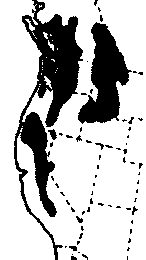
Range map (6).
Common Names
Western white pine; silver, soft, fingercone, mountain, Idaho, or little sugar pine (5); pin argenté (1).Taxonomic notes
Syn: Strobus monticola (Douglas ex D. Don) Rydberg (1).Description
Trees 30(70) m tall and 100(250) cm in diameter, straight; crown narrowly conic, becoming broad and flattened. Bark grey and thin, smooth, becoming furrowed into distinctive rectangular to hexagonal scaly plates in large individuals. Branches nearly whorled, spreading-ascending; twigs slender, pale red-brown, rusty puberulent and slightly glandular (rarely glabrous), aging purple-brown or gray, smooth. Buds ellipsoid or cylindric, rust-colored, 0.4-0.5cm, slightly resinous. Needles 5 per fascicle, spreading to ascending, persisting 3-4 years, 4-10 cm x 0.7-1 mm, straight, slightly twisted, pliant, blue-green, abaxial surface without evident stomatal lines, adaxial surfaces with evident stomatal lines, margins finely serrulate, apex broadly to narrowly acute; sheath 1-1.5 cm, shed early. Staminate cones ellipsoid, 10-15 mm, yellow. Ovulate cones maturing in 2 years, shedding seeds and falling soon thereafter, clustered, pendent, symmetric, lance-cylindric to ellipsoid-cylindric before opening, broadly lanceoloid to ellipsoid-cylindric when open, 10-25 cm, creamy brown to yellowish, without purple or gray tints, resinous, stalks to 2 cm; umbo terminal, depressed. Seeds compressed, broadly obovoid-deltoid; body 5-7 mm, red-brown; wing 2-2.5 cm. 2 n =24 (1, 2).Range
Western USA: Washington, Montana, Idaho, Nevada, Oregon, California; and Canada: Alberta, British Columbia; to 1000 m in N, and at 1900-3000 m in the S. Occurs in lowland fog forests or on moist mountain soils, occasionally in forested bogs. Usually in mixed conifer forests, occasionally in pure stands (1, 2). See also (7).Big Tree
Diameter 318 cm, height 46 m, crown spread 16 m, in Eldorado National Forest, CA (3). This tree's large diameter is due to the fact that it has a double trunk. Also, height 69.2 m, dbh 200 cm, in Floodwood State Forest, ID (9).Oldest
Dendrochronology
Ethnobotany
Once the preferred wood for matches (1), it is no longer a major timber tree.Observations
It is the only big pine in western Washington and northwest Oregon, and seems to be easily found in inland coniferous forests throughout that area.Remarks
White pine blister rust ( Cronartium ribicola ), an introduced fungal disease, has decimated formerly extensive stands of this and certain other white pines (2).Western white pine is the state tree of Idaho (1).
Citations
(1) Kral in the Flora of North America online .(2) Little 1980 .
(3) American Forests 1996 .
(4) E-mail communication from Robert Van Pelt, who measured these trees; 18-Mar-1998.
(5) Peattie 1950 .
(6) Burns & Honkala 1990 .
(7) Robert S. Thompson, Katherine H. Anderson and Patrick J. Bartlein. 1999. Atlas of Relations Between Climatic Parameters and Distributions of Important Trees and Shrubs in North America. U.S. Geological Survey Professional Paper 1650 A&B. URL= http://greenwood.cr.usgs.gov/pub/ppapers/p1650-a/pages/conifers.html , accessed 22-Jan-2000.
(9) E-mail communication from Robert Van Pelt, 21-Apr-1998.
See also:
Arno & Gyer 1973
.
Elias 1987
.
FEIS database
.
Lanner 1983
.
Silba 1986
.
[ Pinus ] [ Pinaceae ] [ home ]
This page is from the Gymnosperm Database
URL: http://www.geocities.com/~earlecj/pi/pin/monticola.htm
Edited by Christopher J. Earle
E-mail:
earlecj@earthlink.com
Last modified on 28-Jan-2000